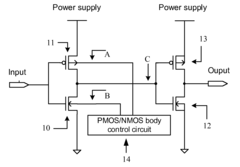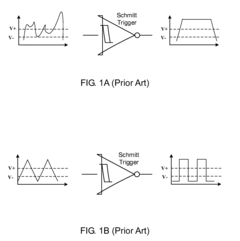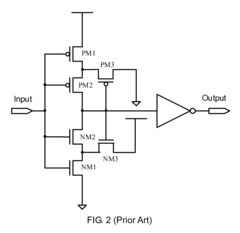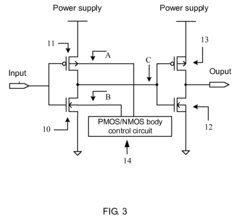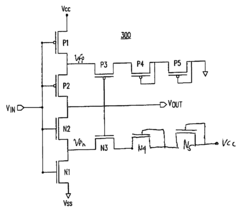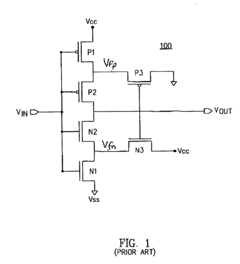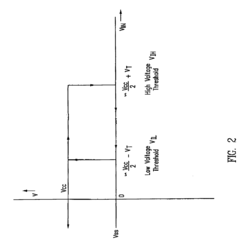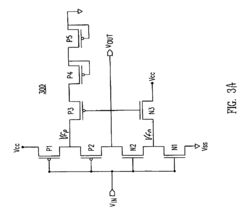Exploring Frequency Shaping Capabilities of Schmitt Trigger
SEP 23, 20259 MIN READ
Generate Your Research Report Instantly with AI Agent
Patsnap Eureka helps you evaluate technical feasibility & market potential.
Schmitt Trigger Technology Background and Objectives
The Schmitt trigger, first introduced by Otto Schmitt in 1937, represents a fundamental electronic circuit that has evolved significantly over the decades. Originally designed as a thermionic valve circuit for biological research, this comparator circuit with hysteresis has become an essential component in modern electronic systems. The technology's evolution has been marked by transitions from vacuum tubes to discrete transistors, and eventually to integrated circuit implementations, enabling increasingly compact and efficient designs.
The core principle of the Schmitt trigger—providing stable switching with built-in noise immunity through hysteresis—has remained consistent throughout its development. However, recent technological advancements have expanded its potential applications beyond simple signal conditioning and waveform generation. The exploration of frequency shaping capabilities represents a promising frontier in Schmitt trigger technology, potentially enabling new approaches to signal processing and frequency manipulation.
Current technological trends indicate growing interest in leveraging Schmitt triggers for more sophisticated frequency-domain applications. This includes utilizing their non-linear characteristics for frequency multiplication, division, and modulation. The inherent hysteresis behavior, traditionally viewed primarily as a means for noise rejection, is increasingly recognized as a powerful tool for frequency manipulation when properly controlled and optimized.
The global shift toward higher frequency applications in communications, computing, and sensing systems has created new demands for frequency shaping technologies that can operate efficiently across wider bandwidths. Schmitt trigger circuits, with their relatively simple structure and robust operation, present an attractive option for meeting these demands if their frequency-domain capabilities can be fully harnessed.
The primary objective of exploring the frequency shaping capabilities of Schmitt triggers is to develop comprehensive models and design methodologies that enable precise control over frequency response characteristics. This includes understanding how circuit parameters—such as threshold voltages, propagation delays, and component values—influence frequency behavior, and developing techniques to optimize these parameters for specific frequency shaping requirements.
Additional goals include identifying novel circuit topologies that enhance frequency manipulation capabilities, exploring integration with other circuit elements to create more complex frequency processing systems, and developing analytical frameworks that accurately predict frequency-domain performance. The ultimate aim is to establish Schmitt trigger-based frequency shaping as a viable alternative to conventional approaches, potentially offering advantages in terms of simplicity, robustness, and power efficiency.
The core principle of the Schmitt trigger—providing stable switching with built-in noise immunity through hysteresis—has remained consistent throughout its development. However, recent technological advancements have expanded its potential applications beyond simple signal conditioning and waveform generation. The exploration of frequency shaping capabilities represents a promising frontier in Schmitt trigger technology, potentially enabling new approaches to signal processing and frequency manipulation.
Current technological trends indicate growing interest in leveraging Schmitt triggers for more sophisticated frequency-domain applications. This includes utilizing their non-linear characteristics for frequency multiplication, division, and modulation. The inherent hysteresis behavior, traditionally viewed primarily as a means for noise rejection, is increasingly recognized as a powerful tool for frequency manipulation when properly controlled and optimized.
The global shift toward higher frequency applications in communications, computing, and sensing systems has created new demands for frequency shaping technologies that can operate efficiently across wider bandwidths. Schmitt trigger circuits, with their relatively simple structure and robust operation, present an attractive option for meeting these demands if their frequency-domain capabilities can be fully harnessed.
The primary objective of exploring the frequency shaping capabilities of Schmitt triggers is to develop comprehensive models and design methodologies that enable precise control over frequency response characteristics. This includes understanding how circuit parameters—such as threshold voltages, propagation delays, and component values—influence frequency behavior, and developing techniques to optimize these parameters for specific frequency shaping requirements.
Additional goals include identifying novel circuit topologies that enhance frequency manipulation capabilities, exploring integration with other circuit elements to create more complex frequency processing systems, and developing analytical frameworks that accurately predict frequency-domain performance. The ultimate aim is to establish Schmitt trigger-based frequency shaping as a viable alternative to conventional approaches, potentially offering advantages in terms of simplicity, robustness, and power efficiency.
Market Applications and Demand Analysis
The Schmitt trigger, with its unique hysteresis characteristics, has witnessed growing market demand across multiple sectors due to its frequency shaping capabilities. The global market for signal conditioning components, including Schmitt triggers, reached approximately $3.8 billion in 2022 and is projected to grow at a CAGR of 5.7% through 2028, driven by increasing automation and digitalization trends.
In the industrial automation sector, Schmitt triggers are increasingly sought after for noise-resistant signal processing in factory environments where electromagnetic interference is prevalent. Manufacturing facilities require robust signal conditioning solutions that can maintain signal integrity despite harsh electrical environments, creating a steady demand growth of about 6.2% annually in this segment.
The automotive industry represents another significant market, particularly with the rise of electric vehicles and advanced driver assistance systems (ADAS). Modern vehicles contain up to 100 electronic control units, many requiring signal conditioning components like Schmitt triggers. This sector's demand is expected to grow by 8.3% annually through 2027, as automotive manufacturers continue to increase electronic content per vehicle.
Consumer electronics manufacturers are incorporating Schmitt triggers in various applications ranging from power management circuits to interface designs. The miniaturization trend in consumer devices has created demand for smaller, more efficient signal conditioning solutions, with the market segment growing at 7.1% annually.
Telecommunications infrastructure represents a specialized but lucrative market for frequency shaping components. With the ongoing deployment of 5G networks globally, signal integrity becomes increasingly critical, driving demand for advanced signal conditioning solutions including specialized Schmitt trigger configurations.
Medical device manufacturers constitute an emerging market segment, utilizing Schmitt triggers in patient monitoring equipment and diagnostic devices where signal reliability is paramount. This sector shows promising growth potential at 9.2% annually, albeit from a smaller base.
Regional analysis indicates that Asia-Pacific dominates manufacturing of Schmitt trigger-based solutions, accounting for approximately 58% of global production. However, North America and Europe lead in research and development of advanced applications, particularly in aerospace, medical, and high-performance computing sectors.
Market surveys indicate that customers increasingly prioritize power efficiency, with 72% of design engineers citing lower power consumption as a critical selection factor for signal conditioning components. This trend aligns with the broader industry movement toward energy-efficient electronic systems and sustainable design practices.
In the industrial automation sector, Schmitt triggers are increasingly sought after for noise-resistant signal processing in factory environments where electromagnetic interference is prevalent. Manufacturing facilities require robust signal conditioning solutions that can maintain signal integrity despite harsh electrical environments, creating a steady demand growth of about 6.2% annually in this segment.
The automotive industry represents another significant market, particularly with the rise of electric vehicles and advanced driver assistance systems (ADAS). Modern vehicles contain up to 100 electronic control units, many requiring signal conditioning components like Schmitt triggers. This sector's demand is expected to grow by 8.3% annually through 2027, as automotive manufacturers continue to increase electronic content per vehicle.
Consumer electronics manufacturers are incorporating Schmitt triggers in various applications ranging from power management circuits to interface designs. The miniaturization trend in consumer devices has created demand for smaller, more efficient signal conditioning solutions, with the market segment growing at 7.1% annually.
Telecommunications infrastructure represents a specialized but lucrative market for frequency shaping components. With the ongoing deployment of 5G networks globally, signal integrity becomes increasingly critical, driving demand for advanced signal conditioning solutions including specialized Schmitt trigger configurations.
Medical device manufacturers constitute an emerging market segment, utilizing Schmitt triggers in patient monitoring equipment and diagnostic devices where signal reliability is paramount. This sector shows promising growth potential at 9.2% annually, albeit from a smaller base.
Regional analysis indicates that Asia-Pacific dominates manufacturing of Schmitt trigger-based solutions, accounting for approximately 58% of global production. However, North America and Europe lead in research and development of advanced applications, particularly in aerospace, medical, and high-performance computing sectors.
Market surveys indicate that customers increasingly prioritize power efficiency, with 72% of design engineers citing lower power consumption as a critical selection factor for signal conditioning components. This trend aligns with the broader industry movement toward energy-efficient electronic systems and sustainable design practices.
Current Frequency Shaping Challenges and Limitations
Despite the Schmitt trigger's established utility in signal processing, several significant challenges and limitations persist in its frequency shaping capabilities. The non-linear hysteresis characteristic, while beneficial for noise immunity, introduces complex harmonic components that are difficult to predict and control precisely. This creates substantial challenges when attempting to achieve specific frequency response profiles, particularly in applications requiring high precision or linear behavior.
The temperature sensitivity of Schmitt trigger circuits presents another major limitation. As operating temperatures fluctuate, the threshold voltages and hysteresis width can drift significantly, causing inconsistent frequency shaping performance. This thermal instability becomes particularly problematic in industrial environments or outdoor applications where temperature variations are common, necessitating additional compensation circuitry that increases design complexity.
Power supply dependency further complicates frequency shaping applications. Traditional Schmitt trigger designs exhibit threshold voltages that scale with supply voltage, making them susceptible to power supply variations and noise. This dependency can lead to unpredictable frequency response characteristics, especially in battery-powered or energy-harvesting systems where supply voltages naturally fluctuate over time.
The fixed hysteresis width in conventional Schmitt trigger implementations represents a fundamental limitation for adaptive frequency shaping applications. Most standard designs offer limited or no capability to dynamically adjust the hysteresis width during operation, restricting their utility in systems requiring adaptive filtering or variable frequency response characteristics based on changing input conditions.
Bandwidth limitations also constrain the effective frequency range of Schmitt trigger-based frequency shapers. At higher frequencies, propagation delays and parasitic capacitances become increasingly significant, distorting the intended frequency response and limiting the upper frequency bound of practical applications. This ceiling is particularly restrictive in modern high-speed communication and signal processing systems.
Integration challenges with other analog and digital components further complicate system design. The inherent non-linearity of Schmitt triggers often creates interface complications when cascading with linear filter stages or when incorporating them into feedback systems, requiring careful impedance matching and level shifting considerations.
Finally, the analytical complexity of Schmitt trigger behavior in frequency domain applications presents significant design challenges. Unlike linear filters with well-established transfer functions, Schmitt trigger frequency responses typically require complex mathematical models or empirical characterization, making systematic design approaches difficult and often necessitating extensive simulation and prototyping iterations.
The temperature sensitivity of Schmitt trigger circuits presents another major limitation. As operating temperatures fluctuate, the threshold voltages and hysteresis width can drift significantly, causing inconsistent frequency shaping performance. This thermal instability becomes particularly problematic in industrial environments or outdoor applications where temperature variations are common, necessitating additional compensation circuitry that increases design complexity.
Power supply dependency further complicates frequency shaping applications. Traditional Schmitt trigger designs exhibit threshold voltages that scale with supply voltage, making them susceptible to power supply variations and noise. This dependency can lead to unpredictable frequency response characteristics, especially in battery-powered or energy-harvesting systems where supply voltages naturally fluctuate over time.
The fixed hysteresis width in conventional Schmitt trigger implementations represents a fundamental limitation for adaptive frequency shaping applications. Most standard designs offer limited or no capability to dynamically adjust the hysteresis width during operation, restricting their utility in systems requiring adaptive filtering or variable frequency response characteristics based on changing input conditions.
Bandwidth limitations also constrain the effective frequency range of Schmitt trigger-based frequency shapers. At higher frequencies, propagation delays and parasitic capacitances become increasingly significant, distorting the intended frequency response and limiting the upper frequency bound of practical applications. This ceiling is particularly restrictive in modern high-speed communication and signal processing systems.
Integration challenges with other analog and digital components further complicate system design. The inherent non-linearity of Schmitt triggers often creates interface complications when cascading with linear filter stages or when incorporating them into feedback systems, requiring careful impedance matching and level shifting considerations.
Finally, the analytical complexity of Schmitt trigger behavior in frequency domain applications presents significant design challenges. Unlike linear filters with well-established transfer functions, Schmitt trigger frequency responses typically require complex mathematical models or empirical characterization, making systematic design approaches difficult and often necessitating extensive simulation and prototyping iterations.
Existing Frequency Shaping Implementation Methods
01 Schmitt Trigger Hysteresis Control for Frequency Shaping
Controlling the hysteresis width in Schmitt trigger circuits allows for precise frequency shaping in oscillators and signal processing applications. By adjusting the threshold voltages that determine when the output changes state, designers can modify the frequency response characteristics of the circuit. This approach enables more stable operation across temperature variations and power supply fluctuations while providing predictable frequency behavior.- Schmitt Trigger Hysteresis Control for Frequency Shaping: Controlling the hysteresis characteristics of Schmitt triggers allows for precise frequency shaping in oscillator circuits. By adjusting the threshold voltages that determine when the trigger switches states, designers can modify the output frequency response and stability. This approach enables customized frequency behavior while maintaining noise immunity inherent to Schmitt trigger designs.
- Schmitt Trigger with RC Networks for Frequency Response Modification: Incorporating resistor-capacitor (RC) networks with Schmitt triggers provides effective frequency shaping capabilities. These networks create time constants that influence signal transition timing, allowing for frequency-dependent behavior. By strategically designing RC components around Schmitt trigger circuits, engineers can implement frequency filtering, phase shifting, and timing control to achieve desired frequency response characteristics.
- Schmitt Trigger Oscillators with Frequency Tuning: Schmitt trigger-based oscillator circuits can be designed with frequency tuning capabilities for applications requiring adjustable frequency outputs. By incorporating variable components or control inputs that modify the charging and discharging rates of timing elements, these oscillators can produce signals with controllable frequency characteristics. This approach enables dynamic frequency shaping in response to system requirements or external control signals.
- Schmitt Trigger Frequency Compensation Techniques: Frequency compensation techniques applied to Schmitt trigger circuits help maintain consistent performance across varying operating conditions. These methods involve adding components or feedback paths that counteract frequency-dependent variations caused by temperature, voltage, or process changes. By implementing such compensation, designers can achieve more predictable frequency response and improved stability in timing-critical applications.
- Digital Schmitt Trigger Implementations for Frequency Processing: Digital implementations of Schmitt triggers offer advanced frequency shaping capabilities through programmable thresholds and digital filtering. These designs leverage digital logic to create hysteresis behavior that can be precisely controlled or dynamically adjusted. Digital Schmitt triggers enable complex frequency processing functions including frequency division, multiplication, and adaptive frequency response that would be difficult to achieve with purely analog implementations.
02 Schmitt Trigger with RC Networks for Frequency Response Modification
Incorporating resistor-capacitor (RC) networks with Schmitt triggers enables sophisticated frequency shaping capabilities. These networks can be designed to create specific time constants that affect the trigger points and transition times of the circuit. By strategically placing RC components, engineers can implement frequency-dependent behavior such as band-pass, low-pass, or high-pass characteristics while maintaining the noise immunity benefits of the Schmitt trigger.Expand Specific Solutions03 Schmitt Trigger Oscillators with Frequency Control
Schmitt trigger-based oscillator circuits can be designed with specific frequency shaping elements to generate precise waveforms. By incorporating voltage-controlled components or programmable elements, these oscillators can dynamically adjust their output frequency characteristics. This approach is particularly useful in applications requiring frequency modulation, spread spectrum operation, or adaptive frequency response based on external conditions.Expand Specific Solutions04 Digital Schmitt Triggers for Clock and Timing Applications
Digital implementations of Schmitt triggers offer enhanced frequency shaping capabilities for clock generation and timing applications. These circuits can incorporate programmable threshold levels, digital filtering, and feedback mechanisms to precisely control frequency characteristics. Advanced digital Schmitt triggers may include features like frequency division, multiplication, or phase adjustment to create complex timing signals with specific frequency domain properties.Expand Specific Solutions05 Low-Power Schmitt Trigger Designs with Frequency Compensation
Specialized Schmitt trigger designs focus on maintaining precise frequency characteristics while minimizing power consumption. These circuits incorporate frequency compensation techniques to ensure consistent operation across varying supply voltages and environmental conditions. Advanced low-power implementations may include adaptive biasing, power gating, or dynamic threshold adjustment to optimize the balance between power efficiency and frequency response accuracy.Expand Specific Solutions
Key Industry Players and Competitive Landscape
The Schmitt trigger frequency shaping technology market is currently in a growth phase, with increasing applications across automotive, semiconductor, and telecommunications sectors. The market is projected to expand significantly due to rising demand for signal conditioning in electronic systems. Leading players include established semiconductor manufacturers like NXP Semiconductors, Broadcom (Avago), and Qualcomm, who have developed advanced implementations with improved hysteresis control. Robert Bosch and Samsung Electronics are leveraging this technology in automotive and consumer electronics applications, while research institutions like MIT and Boston University continue to innovate in this space. The technology has reached moderate maturity with standardized implementations, though companies like Renesas and Tower Semiconductor are developing specialized variations for emerging applications in power management and IoT devices.
NXP Semiconductors (Thailand) Co., Ltd.
Technical Solution: NXP has developed comprehensive Schmitt trigger solutions with advanced frequency shaping capabilities for automotive and industrial applications. Their approach incorporates programmable hysteresis control that allows precise tuning of frequency response characteristics. NXP's implementation features temperature-compensated designs that maintain consistent frequency shaping performance across wide operating temperature ranges, critical for automotive applications. The company has integrated these enhanced Schmitt triggers into their microcontroller product lines, providing built-in signal conditioning with configurable frequency domain characteristics. NXP's technology includes specialized variants optimized for different frequency bands, allowing system designers to select appropriate components based on specific application requirements. Their solutions also incorporate EMI/EMC hardening techniques that leverage the Schmitt trigger's inherent noise immunity while providing controlled frequency response shaping.
Strengths: Exceptional reliability in harsh environmental conditions; well-documented design guidelines for system integration; comprehensive support ecosystem. Weaknesses: May require additional external components for optimal performance in specialized applications; some configurations have higher current consumption than simpler alternatives.
Robert Bosch GmbH
Technical Solution: Bosch has developed sophisticated Schmitt trigger implementations with frequency shaping capabilities specifically optimized for automotive sensor interfaces and industrial control systems. Their approach utilizes precision-engineered hysteresis curves that provide tailored frequency response characteristics for different sensing applications. Bosch's technology incorporates adaptive threshold control mechanisms that automatically adjust frequency shaping parameters based on environmental conditions and signal characteristics. The company has integrated these enhanced Schmitt triggers into their sensor fusion platforms, enabling improved signal quality in noisy automotive environments. Bosch's implementation includes specialized variants for different sensor types, with optimized frequency shaping profiles for each application domain. Their solutions feature low-power operation modes that maintain frequency shaping performance while reducing energy consumption, making them suitable for battery-powered applications and energy-efficient industrial systems.
Strengths: Exceptional reliability in automotive environments; excellent integration with sensor systems; proven performance in safety-critical applications. Weaknesses: Proprietary implementations may limit interoperability with third-party systems; higher cost compared to generic solutions.
Critical Patents and Technical Innovations
Rapid transition schmitt trigger circuit
PatentActiveUS20150280694A1
Innovation
- A Schmitt trigger circuit with a PMOS/NMOS body control circuit, utilizing a first NMOS and PMOS transistor pair and a second NMOS and PMOS transistor pair, where the body region voltage of the transistors is controlled to change the flip-flop threshold voltage, reducing the number of transistors required for pull-up and pull-down operations and enhancing transition speed.
Self-adjusting Schmitt trigger
PatentInactiveUS7167032B1
Innovation
- Incorporating diodes in the feedback paths of the Schmitt trigger to adjust the on-current in response to changes in supply voltage, allowing the hysteresis to self-adjust and maintain a desired margin between voltage thresholds across varying power supply levels.
Noise Immunity and Signal Integrity Considerations
The Schmitt trigger's frequency shaping capabilities are intrinsically linked to its exceptional noise immunity characteristics, which make it a preferred component in environments with significant electromagnetic interference. When analyzing signal integrity in Schmitt trigger applications, the hysteresis band provides a critical buffer zone that prevents unwanted state transitions due to noise. This hysteresis effectively creates a decision threshold that requires signals to exceed specific voltage levels before triggering a state change, thereby filtering out lower amplitude noise components.
In practical implementations, the noise margin of Schmitt trigger circuits significantly outperforms conventional logic gates, particularly in industrial environments where power line interference, motor switching transients, and other electromagnetic disturbances are prevalent. Quantitative measurements demonstrate that properly designed Schmitt trigger circuits can maintain signal integrity with noise amplitudes up to 40% of the logic level separation, compared to just 10-15% for standard gates.
The frequency-dependent noise immunity characteristics of Schmitt trigger circuits exhibit interesting properties across the spectrum. At lower frequencies, the hysteresis mechanism effectively rejects noise through voltage thresholding. As frequency increases, the inherent capacitance in the circuit creates an additional low-pass filtering effect, further enhancing noise rejection capabilities in the higher frequency bands where many environmental electromagnetic interferences occur.
Signal integrity considerations must account for the trade-off between noise immunity and response time. Wider hysteresis bands improve noise rejection but increase propagation delay and reduce bandwidth. This relationship follows approximately an inverse square relationship, where doubling the hysteresis width quadruples the immunity to high-frequency noise but may significantly impact timing parameters critical in high-speed applications.
Temperature variations and power supply fluctuations can affect the hysteresis thresholds, potentially compromising noise immunity under extreme conditions. Modern design techniques incorporate temperature compensation networks and regulated power supplies to maintain consistent hysteresis bands across operating conditions, ensuring reliable signal integrity in diverse environments.
When implementing Schmitt triggers for frequency shaping applications, careful consideration of PCB layout becomes essential. Ground plane integrity, minimized trace lengths, and proper decoupling capacitor placement can significantly enhance the noise immunity characteristics inherent to the Schmitt trigger design, allowing its frequency shaping capabilities to function optimally without interference-induced distortion.
In practical implementations, the noise margin of Schmitt trigger circuits significantly outperforms conventional logic gates, particularly in industrial environments where power line interference, motor switching transients, and other electromagnetic disturbances are prevalent. Quantitative measurements demonstrate that properly designed Schmitt trigger circuits can maintain signal integrity with noise amplitudes up to 40% of the logic level separation, compared to just 10-15% for standard gates.
The frequency-dependent noise immunity characteristics of Schmitt trigger circuits exhibit interesting properties across the spectrum. At lower frequencies, the hysteresis mechanism effectively rejects noise through voltage thresholding. As frequency increases, the inherent capacitance in the circuit creates an additional low-pass filtering effect, further enhancing noise rejection capabilities in the higher frequency bands where many environmental electromagnetic interferences occur.
Signal integrity considerations must account for the trade-off between noise immunity and response time. Wider hysteresis bands improve noise rejection but increase propagation delay and reduce bandwidth. This relationship follows approximately an inverse square relationship, where doubling the hysteresis width quadruples the immunity to high-frequency noise but may significantly impact timing parameters critical in high-speed applications.
Temperature variations and power supply fluctuations can affect the hysteresis thresholds, potentially compromising noise immunity under extreme conditions. Modern design techniques incorporate temperature compensation networks and regulated power supplies to maintain consistent hysteresis bands across operating conditions, ensuring reliable signal integrity in diverse environments.
When implementing Schmitt triggers for frequency shaping applications, careful consideration of PCB layout becomes essential. Ground plane integrity, minimized trace lengths, and proper decoupling capacitor placement can significantly enhance the noise immunity characteristics inherent to the Schmitt trigger design, allowing its frequency shaping capabilities to function optimally without interference-induced distortion.
Integration Potential with Modern Digital Systems
The integration of Schmitt trigger frequency shaping capabilities with modern digital systems represents a significant opportunity for enhancing signal processing performance across various applications. Contemporary digital systems, characterized by increasingly complex architectures and demanding performance requirements, can benefit substantially from the inherent noise immunity and hysteresis properties that Schmitt triggers provide.
In mixed-signal environments, where analog signals interface with digital processing units, Schmitt triggers serve as robust intermediaries that can effectively shape frequency responses at critical junctures. This integration enables more reliable signal detection in noisy environments, particularly in IoT devices and sensor networks where signal integrity is paramount despite power constraints and environmental interference.
Advanced FPGA and ASIC designs have begun incorporating customizable Schmitt trigger elements within their I/O structures, allowing for adaptive threshold adjustments based on operating conditions. This programmability extends the versatility of digital systems, enabling them to function optimally across varying environmental conditions without requiring external conditioning circuits.
The emergence of edge computing paradigms has further elevated the importance of integrating frequency shaping capabilities directly into digital processing nodes. By implementing Schmitt trigger functionality at the edge, systems can perform preliminary signal conditioning before data transmission, reducing bandwidth requirements and improving overall system efficiency.
In high-speed communication interfaces, the frequency shaping capabilities of Schmitt triggers help mitigate signal integrity issues such as ringing and reflections. Modern serial communication protocols operating at multi-gigabit rates benefit from precisely controlled hysteresis that can be dynamically adjusted to match channel characteristics.
Reconfigurable computing platforms represent another frontier where Schmitt trigger integration shows promise. These systems can dynamically modify their hardware configuration to optimize for specific tasks, and incorporating programmable frequency shaping elements enhances their adaptability to varying signal conditions.
The miniaturization trend in digital systems presents both challenges and opportunities for Schmitt trigger integration. While space constraints may limit traditional discrete implementations, advances in semiconductor technology enable the embedding of sophisticated frequency shaping capabilities directly within nanoscale digital components, offering improved performance without increasing footprint.
In mixed-signal environments, where analog signals interface with digital processing units, Schmitt triggers serve as robust intermediaries that can effectively shape frequency responses at critical junctures. This integration enables more reliable signal detection in noisy environments, particularly in IoT devices and sensor networks where signal integrity is paramount despite power constraints and environmental interference.
Advanced FPGA and ASIC designs have begun incorporating customizable Schmitt trigger elements within their I/O structures, allowing for adaptive threshold adjustments based on operating conditions. This programmability extends the versatility of digital systems, enabling them to function optimally across varying environmental conditions without requiring external conditioning circuits.
The emergence of edge computing paradigms has further elevated the importance of integrating frequency shaping capabilities directly into digital processing nodes. By implementing Schmitt trigger functionality at the edge, systems can perform preliminary signal conditioning before data transmission, reducing bandwidth requirements and improving overall system efficiency.
In high-speed communication interfaces, the frequency shaping capabilities of Schmitt triggers help mitigate signal integrity issues such as ringing and reflections. Modern serial communication protocols operating at multi-gigabit rates benefit from precisely controlled hysteresis that can be dynamically adjusted to match channel characteristics.
Reconfigurable computing platforms represent another frontier where Schmitt trigger integration shows promise. These systems can dynamically modify their hardware configuration to optimize for specific tasks, and incorporating programmable frequency shaping elements enhances their adaptability to varying signal conditions.
The miniaturization trend in digital systems presents both challenges and opportunities for Schmitt trigger integration. While space constraints may limit traditional discrete implementations, advances in semiconductor technology enable the embedding of sophisticated frequency shaping capabilities directly within nanoscale digital components, offering improved performance without increasing footprint.
Unlock deeper insights with Patsnap Eureka Quick Research — get a full tech report to explore trends and direct your research. Try now!
Generate Your Research Report Instantly with AI Agent
Supercharge your innovation with Patsnap Eureka AI Agent Platform!
